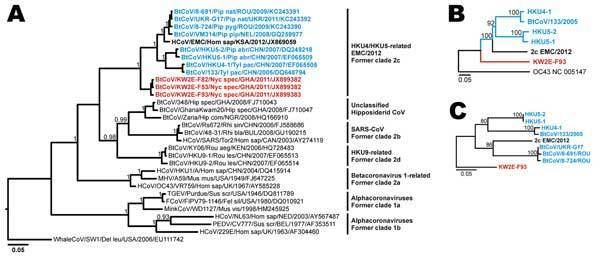Group Group IV ((+)ssRNA) Family Coronaviridae Higher classification Coronavirinae | Order Nidovirales Subfamily Coronavirinae Rank Genus | |
 | ||
Lower classifications Middle East respiratory syndrome coronavirus, SARS coronavirus, Mouse hepatitis virus | ||
Betacoronaviruses are one of four genera of coronaviruses of the subfamily Coronavirinae in the family Coronaviridae, of the order Nidovirales. They are enveloped, positive-sense, single-stranded RNA viruses of zoonotic origin. The coronavirus genera are each composed of varying viral lineages with the betacoronavirus genus containing four such lineages.
Contents
The Beta-CoVs of the greatest clinical importance concerning humans are OC43, and HKU1 of the A lineage, SARS-CoV of the B lineage, and MERS-CoV of the C lineage. MERS-CoV is the first betacoronavirus belonging to lineage C that is known to infect humans.
The alpha- and beta-coronavirus genera descend from the bat gene pool.
Virology
SARS-CoV virus causes SARS disease, and MERS-CoV virus causes MERS "Middle East Respiratory Syndrome" disease.
Sequence
Coronaviruses have a large genome size that range from 26 to 32 kilobases.
As of May 2013, GenBank has 46 published complete genomes of the α-(group 1), β-(group 2), γ-(group 3), and δ-(group 4) CoVs.
Classification
Within the genus Betacoronavirus (Group 2 CoV), four lineages (a, b, c, and d) are commonly recognized.
Morphology
The viruses of lineage A differ from all others in the genus in that they have a shorter spike-like protein called hemagglutinin esterase (HE).
The name Coronavirus is derived from the Latin “corona” meaning crown or halo, referring to their image under electron microscopy of crown-like spikes on their surface similar to the solar corona. This morphology is created by the viral spike (S) peplomers, which are proteins that populate the surface of the virus and determine host tropism. The order Nidovirales is named for the Latin nidus, which means nest. It refers to this order’s production of a 3' co-terminal nested set of subgenomic mRNA's during infection.
